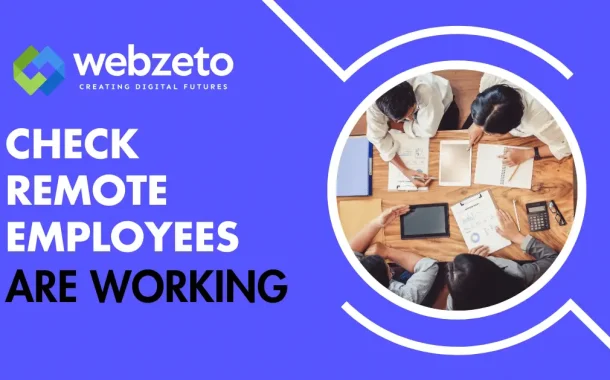Remote work comes with several challenges. Communication can be harder since employees aren’t in the same physical space. It can also be difficult to build a strong team culture and trust. Additionally, employees might face distractions at home or struggle with maintaining a work-life balance. Monitoring helps identify these problems so they can be managed effectively.
Table of Contents
Table of Contents
Setting Clear Expectations
Clearly define each employee’s roles and responsibilities to avoid confusion. Ensure everyone understands their tasks, who they report to, and how their work fits into the bigger picture. Providing detailed job descriptions and regular updates on role expectations helps employees stay focused and aligned with team objectives.
1. Establishing Key Performance Indicators (KPIs)
Set Key Performance Indicators (KPIs) to measure success. KPIs should be specific, measurable, achievable, relevant, and time-bound (SMART). These metrics provide a clear standard for evaluating performance, helping employees understand what targets they need to hit. Regularly review and adjust KPIs to reflect changing goals and priorities.
2. Communicating Goals and Deadlines
Clearly communicate goals and deadlines to keep everyone on track. Regularly update the team on project timelines and any changes to ensure alignment. Use project management tools to track progress and share updates. This helps prevent misunderstandings and ensures that everyone knows what needs to be done and by when.
3. Providing Detailed Instructions and Guidelines
Break down large tasks into manageable steps and provide clear guidelines on how to complete them. Detailed instructions help employees understand the specific requirements of each task, reducing the chance of errors and increasing efficiency. Ensure all instructions are easily accessible and refer back to them as needed.
4. Maintaining Open Lines of Communication
Encourage open and ongoing communication. Create an environment where employees feel comfortable asking questions and seeking clarification. Regular check-ins, team meetings, and one-on-one sessions help maintain clarity and address any concerns promptly. This approach ensures that everyone stays informed and engaged, promoting a cohesive and productive remote work environment.
Using Technology for Monitoring
- Time Tracking Software: Time tracking software helps monitor how employees spend their work hours. Tools like Toggl, Clockify, and Harvest allow employees to log their hours and provide detailed reports on their activities. This helps ensure that time is being used effectively and allows managers to identify any areas where time might be wasted.
- Project Management Tools: Project management tools like Trello, Asana, and Monday.com help keep track of tasks, deadlines, and progress. These platforms allow teams to collaborate in real-time, assign tasks, set deadlines, and monitor progress through visual dashboards. This ensures that everyone is on the same page and that projects stay on track.
- Communication Platforms: To control your Mac or those of your employees remotely, tools like TeamViewer and Kandji are helpful. These tools support instant messaging, video conferencing, and file sharing, making it easier to stay connected and coordinate efforts. Regular use of these platforms helps maintain team cohesion and ensures that information is shared promptly.
- Performance Analytics Tools: Performance analytics tools provide insights into employee productivity and work patterns. Software like Hubstaff and Time Doctor offer detailed analytics and reports on how employees spend their time, including which applications and websites they use. This data helps managers understand productivity trends and identify potential issues early.
- Monitoring Software: Monitoring software such as Teramind and ActivTrak offers comprehensive insights into employee activities. These tools can track application usage, website visits, and even capture screenshots at regular intervals. While it’s important to use these tools ethically and transparently, they can help ensure that employees are staying focused on their work tasks.
- Collaboration Tools: Collaboration tools like Google Workspace and Microsoft Office 365 enable seamless teamwork. These platforms allow multiple users to work on documents, spreadsheets, and presentations simultaneously, making it easier to collaborate on projects and share feedback in real-time. This fosters a collaborative environment even when team members are working remotely.
Performance Metrics to Watch
1. Productivity Metrics
Productivity metrics help gauge how efficiently employees are completing their tasks. Track the number of tasks completed, time taken for each task, and adherence to deadlines. Tools like Trello, Asana, and Monday.com can provide insights into task completion rates and project timelines. Monitoring these metrics ensures that employees are productive and that projects progress smoothly.
2. Quality of Work
Evaluating the quality of work is crucial for maintaining high standards. Regularly assess the accuracy, thoroughness, and creativity of completed tasks. Use peer reviews, client feedback, and quality assurance processes to measure work quality. Providing constructive feedback consistently helps employees improve their performance and maintain high-quality output.
3. Engagement and Participation
Employee engagement and participation are indicators of how involved and motivated remote employees are. Monitor attendance in virtual meetings, participation in discussions, and responsiveness to communications. Tools like Slack and Microsoft Teams can track engagement levels through message activity and meeting attendance. Recognizing such efforts through thoughtful employee rewards and recognition can further motivate remote teams and make them feel seen and appreciated, even from a distance.
4. Task Completion Rates
Tracking task completion rates provides insight into an employee’s efficiency and reliability. Monitor deadlines met and the time taken to finish tasks compared to estimates. High completion rates within the expected time frames indicate efficient work habits and good time management skills.
5. Customer Feedback
Customer feedback is a direct measure of an employee’s performance, especially in customer-facing roles. Collect and review feedback from clients and customers to understand how well employees meet their needs and expectations. Positive feedback indicates strong performance, while negative feedback highlights areas for improvement.
6. Initiative and Innovation
Assessing how often employees take the initiative or propose innovative solutions can provide insights into their engagement and commitment. Employees who proactively suggest improvements or new ideas demonstrate high engagement and a commitment to the company’s success. Encourage and recognize such behaviors to foster a culture of innovation.
Regular Check-Ins and Updates
By implementing regular check-ins and updates, managers can maintain effective communication, monitor progress. Provide timely support to their remote employees, ensuring a productive and cohesive work environment.
1. Scheduled Meetings
Regular check-ins through scheduled meetings are essential for maintaining communication and tracking progress. Weekly or bi-weekly meetings help ensure everyone is aligned with the project goals and deadlines. Use these meetings to discuss ongoing tasks, address any issues, and provide feedback. Tools like Zoom, Microsoft Teams, and Google Meet facilitate virtual meetings, making it easy for remote teams to stay connected.
2. One-on-One Conversations
One-on-one conversations between managers and employees are crucial for personalized feedback and support. These sessions provide an opportunity to discuss individual performance, address specific concerns, and offer guidance tailored to each employee’s needs. Regular one-on-ones help build trust and rapport, ensuring employees feel valued and heard.
3. Progress Reports
Progress reports are a structured way to keep track of work and accomplishments. Encourage employees to submit regular updates on their tasks, challenges, and achievements. These reports can be weekly or monthly, depending on the project requirements. They provide a clear record of what has been done and what needs to be addressed, helping managers identify patterns and potential issues early.
4. Use of Project Management Tools
Leverage project management tools like Asana, Trello, and Monday.com to keep track of progress and updates in real-time. These tools offer features like task assignments, deadline tracking, and progress visualization through dashboards and Gantt charts. They help teams stay organized and provide a transparent view of project status for everyone involved.
5. Feedback Sessions
Regular feedback sessions are vital for continuous improvement. Use these sessions to provide constructive feedback, recognize achievements, and discuss areas for development. Feedback should be specific, actionable, and delivered in a supportive manner. Regular feedback helps employees understand their strengths and areas for improvement, fostering a growth-oriented work culture.
6. Status Updates in Communication Platforms
Utilize communication platforms like Slack or Microsoft Teams for quick status updates. Create dedicated channels for different projects or teams where members can post daily or weekly updates. This keeps everyone informed about the latest developments and facilitates quick resolution of any issues that arise.
Building Trust and Accountability
Transparency is key to building trust among remote employees. Share information openly about company goals, strategies, and performance. Encourage employees to be honest about their progress, challenges, and needs. When employees feel they are part of the bigger picture, they are more likely to trust leadership and feel accountable for their contributions.
1. Encouraging Self-Reporting
Encourage employees to self-report their progress and any obstacles they encounter. This practice not only promotes accountability but also empowers employees to take ownership of their work. Tools like daily or weekly status reports, project management software, and regular check-ins can facilitate self-reporting. When employees consistently update their status, it builds a sense of responsibility and trustworthiness.
2. Providing Feedback and Support
Regular feedback is essential for fostering accountability and trust. Provide constructive, specific, and timely feedback to help employees understand their strengths and areas for improvement. Offer support and resources to help them overcome challenges. A supportive approach shows that management is invested in employees’ success, which in turn builds trust and encourages accountability.
3. Setting Clear Goals and Expectations
Clear goals and expectations help employees understand what is expected of them and how their work contributes to the team’s success. Set specific, measurable, achievable, relevant, and time-bound (SMART) goals. When employees know what they need to achieve, they can better align their efforts and feel more accountable for their performance.
4. Recognizing and Rewarding Efforts
Recognizing and rewarding employees’ efforts and achievements boosts morale and reinforces accountability. Acknowledge both big and small accomplishments publicly and privately. Implement recognition programs, such as employee of the month or performance bonuses, to motivate employees. When employees see that their hard work is valued, they are more likely to maintain high standards and feel accountable for their work.
5. Building Relationships and Trust
Building strong relationships within the team is crucial for trust. Encourage team-building activities, both virtual and in-person when possible, to strengthen bonds. Regular one-on-one meetings help managers understand employees’ individual needs, goals, and concerns. When employees feel connected to their colleagues and managers, they are more likely to trust the team and feel accountable for their role within it.
6. Promoting a Positive Work Culture
A positive work culture fosters trust and accountability. Promote values like integrity, respect, and collaboration. Ensure that company policies and practices reflect these values consistently. When employees work in a positive environment where they feel respected and valued, they are more likely to exhibit trust and accountability in their work.
Recognizing and Addressing Issues
Early identification of underperformance is crucial. Look for signs such as missed deadlines, lower quality of work, reduced communication, and decreased engagement in team activities. Utilize performance metrics and regular check-ins to spot these issues. Pay attention to feedback from colleagues and clients, as they can provide additional insights into an employee’s performance.
- Implementing Corrective Measures: Once issues are identified, implement corrective measures promptly. Start by having a candid conversation with the employee to understand the root cause of the problem. Develop an improvement plan that includes specific, achievable goals and a timeline for progress. Provide additional training or resources if necessary. Regularly monitor progress and offer ongoing support and feedback to ensure the employee stays on track.
- Offering Training and Development: Continuous training and development can help address performance issues and prevent them from recurring. Offer targeted training sessions to address specific skill gaps. Encourage employees to take advantage of online courses, workshops, and webinars relevant to their roles. Providing opportunities for professional growth shows employees that the company is invested in their development, which can boost morale and performance.
- Providing Constructive Feedback: Constructive feedback is essential for addressing performance issues effectively. Focus on specific behaviors and outcomes rather than personal attributes. Use clear, actionable language to explain what needs improvement and how it can be achieved. Balance criticism with positive reinforcement to encourage employees and maintain their motivation.
- Documenting Performance Issues: Keep a detailed record of performance issues and the steps taken to address them. Documenting these interactions helps create a clear trail of communication and actions, which can be useful if further action is required. Ensure that the documentation is factual and objective, focusing on specific incidents and outcomes.
- Encouraging Open Communication: Encourage open communication to create an environment where employees feel comfortable discussing their challenges. Regularly ask for their input and listen to their concerns. This approach helps build trust and ensures that issues are addressed before they escalate. Open communication also allows for a better understanding of any external factors that might be affecting performance.
- Supporting Employee Well-being: Employee well-being is closely tied to performance. Ensure that employees have access to resources that support their physical and mental health, such as flexible work hours, wellness programs, and counseling services. A healthy work-life balance can significantly improve performance and job satisfaction.
FAQs
Q. How can I ensure remote employees are staying productive without micromanaging?
Use project management tools to track progress and set clear deadlines. Trust your employees and focus on results rather than constant monitoring.
Q. What are some ways to motivate remote employees?
Offer regular recognition, provide opportunities for professional development, and create a positive and inclusive team culture.
Q. How do I handle time zone differences with a remote team?
Schedule meetings at times that work for everyone as much as possible. Use asynchronous communication tools to ensure everyone stays updated regardless of time zones.
Q. What should I do if a remote employee is consistently missing deadlines?
Have a private conversation to understand the root cause. Set clear expectations and provide support, such as additional training or resources.
Q. How can I build team cohesion with remote employees?
Organize regular virtual team-building activities, encourage open communication, and create informal channels for social interactions.
Conclusion
Making sure remote employees are working well means using clear expectations, the right tools, regular check-ins, and building trust. Set clear roles and goals for each employee. Use tools like project management software and communication platforms to stay connected and track progress. Regularly monitor performance metrics to keep an eye on productivity and engagement.
Give regular feedback and support to help employees improve. Address any issues quickly to keep projects on track. Build a culture of transparency and trust so employees feel comfortable taking responsibility for their work. By using these simple strategies, managers can effectively manage remote teams and achieve their goals.














